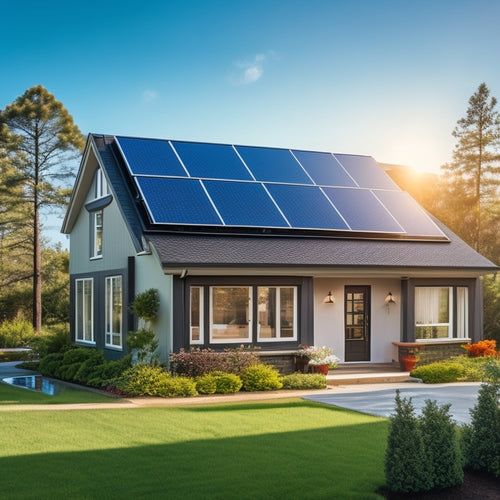
What Are Home Solar Installation and Maintenance Prices
Share
You can expect to pay between $2.50 and $3.50 per watt for a home solar installation, with total costs ranging from $15,000 to $23,000 for a typical residential system. The cost is influenced by equipment quality, installation complexity, and location, among other factors. Financing options and federal and state incentives can help reduce upfront costs. Maintenance and repair costs, including routine tasks and unexpected repairs, will add to your overall expenses. Understanding these factors will help you make an informed decision, and exploring further will reveal more detailed information on what to expect from your home solar installation and maintenance experience.
Key Takeaways
- The average cost of solar panels ranges from $2.50 to $3.50 per watt, with total residential system costs between $15,000 and $23,000.
- System size and installation complexity influence costs, with smaller systems (2-3 kW) costing between $15,000 and $20,000, and larger systems (10-12 kW) ranging from $40,000 to $60,000.
- Routine maintenance accounts for about 5% of overall installation costs over 25 years, with unexpected repairs ranging from $100 to $5,000 or more.
- Ongoing solar system expenses include budgeting for routine maintenance tasks, regular monitoring, and potential unexpected repairs, with documentation aiding in warranty claims.
- Financing options and incentives, such as federal and state incentives, can significantly reduce upfront costs and alleviate ongoing expense burdens.
Average Cost of Solar Panels
On average, a homeowner can expect to pay between $2.50 and $3.50 per watt of solar power, making the total cost of a typical residential solar panel system around $15,000 to $23,000.
This cost can vary depending on factors such as the quality of the equipment, the complexity of the installation, and the location of your home.
Fortunately, you can reduce the upfront cost through solar panel financing options, which allow you to pay for the system over time.
Additionally, you may be eligible for solar panel incentives, such as the federal solar investment tax credit (ITC), which can provide a significant reduction in the total cost.
You can also investigate state and local incentives, such as rebates and tax credits, to further offset the cost.
Installation Prices by System Size
Your solar panel system size directly impacts the overall installation cost. The larger the system capacity, the higher the cost. A smaller system with a capacity of 2-3 kilowatts (kW) can cost between $15,000 to $20,000, while a larger system with a capacity of 10-12 kW can range from $40,000 to $60,000.
The installation timeline also plays a significant role in determining the cost. A faster installation timeline typically results in higher labor costs, which can increase the overall installation price. On the other hand, a longer installation timeline can lead to lower labor costs, but may also result in additional costs associated with permits, inspections, and other administrative tasks.
When evaluating installation prices by system size, it's crucial to reflect on your energy needs and budget. A smaller system may be more suitable for a smaller home or apartment, while a larger system may be necessary for a larger home or commercial property.
Maintenance and Repair Costs
As you consider the overall cost of your home solar installation, you'll want to factor in maintenance and repair costs.
Performing routine preventative care tasks, such as cleaning the panels and inspecting the system, can help minimize unexpected repair bills.
Preventative Care Tasks
About 5% of your home solar installation's overall cost goes towards maintenance and repair expenses over its 25-year lifespan. To minimize these expenses, it is crucial to perform regular preventative care tasks to guarantee your system runs efficiently and effectively.
| Task | Frequency | Cost |
|---|---|---|
| Solar panel cleaning | Every 6 months | $100-$200 |
| Battery maintenance | Every 12 months | $200-$300 |
| Inverter inspection | Every 12 months | $100-$200 |
| Electrical connections check | Every 24 months | $150-$250 |
| System monitoring and reporting | Ongoing | $50-$100 per year |
Unexpected Repair Bills
Solar panels aren't immune to unexpected breakdowns, which can lead to costly repair bills. You may experience a sudden drop in energy production or a complete system failure, leaving you scrambling to find a solution. In such cases, you'll need to factor in repair costs, which can range from $100 to $5,000 or more, depending on the severity of the issue.
Fortunately, many solar panel manufacturers offer warranty coverage that can help mitigate these costs. Typically, warranties last between 10 to 25 years and cover parts and labor for repairs. However, it's vital to review your warranty terms to understand what's covered and what's not.
To minimize repair frequency, it's important to perform regular maintenance tasks, such as cleaning the panels and inspecting the system for signs of wear. By doing so, you can identify potential issues early on and address them before they escalate into costly problems.
Additionally, keeping a record of your maintenance activities can help you make a stronger case for warranty claims if you need to file one.
Factors Affecting Solar Prices
You're likely aware that home solar installation prices vary considerably, but what drives these differences?
Two key factors affecting solar prices are system costs, which encompass the expense of solar panels, inverters, and mounting hardware, and location importance, which includes the impact of local building codes, permits, and labor costs on your overall bill.
Understanding these factors will help you make an informed decision about your solar investment.
System Costs
Several factors contribute to the overall cost of a home solar installation, making system costs an essential aspect to take into account when going solar.
You'll want to evaluate the type and quality of solar panels, inverters, and mounting hardware, as well as the complexity of the installation itself.
The cost of solar panels varies depending on their efficiency, durability, and brand reputation. High-efficiency panels may be more expensive, but they can generate more power per hour of sunlight.
You'll also need to assess the cost of inverters, which convert DC power from the panels to AC power for your home.
Additionally, you'll need to factor in the cost of installation, including labor, permits, and inspections.
Fortunately, you can offset these costs with financing options, such as loans or power purchase agreements, and tax incentives, like the federal solar investment tax credit (ITC).
Location Importance
Geography plays a crucial role in determining the cost of a home solar installation, as the location of your property can impact the system's performance and overall price.
You'll find that local incentives can greatly reduce the upfront cost of your solar installation. For instance, some states and cities offer rebates, tax credits, or property tax exemptions for homeowners who invest in solar energy. These incentives can vary widely depending on where you live, so it's important to research the specific benefits available in your area.
Weather also has a significant impact on your solar installation's performance. If you live in an area with frequent cloud cover or heavy shading, your system may require more panels to generate the same amount of electricity.
On the other hand, areas with abundant sunlight can produce more power with fewer panels, reducing the overall cost. Additionally, extreme weather conditions like hurricanes or hail can affect the durability and maintenance requirements of your system.
Inverter Replacement Cost Guide
Replacing a faulty inverter can be an important maintenance task for homeowners with solar panel systems. You'll want to replace it before it affects your energy output. The inverter lifespan typically ranges from 10 to 15 years, depending on the quality and type.
If you've had your system for a while, it's vital to monitor your inverter efficiency, as it may decline over time.
There are various inverter types, including string, micro, and power optimizers. Each has its unique features and advantages.
When selecting a replacement inverter, consider the warranty offered by the manufacturer. Reputable inverter brands like Enphase, SMA, and Fronius often provide extensive warranties. You may also want to investigate inverter upgrades that offer advanced features like monitoring and energy storage capabilities.
The cost of inverter replacement can vary depending on the brand, type, and installation requirements. On average, you can expect to pay between $1,000 to $3,000 for a replacement inverter, including installation.
Be sure to consult with a professional solar installer to guarantee a seamless and efficient inverter installation process.
Ongoing Solar System Expenses
Ongoing maintenance and monitoring are essential to guarantee your solar panel system operates at its peak performance.
You'll need to budget for routine maintenance tasks, such as cleaning the panels and inspecting the system for damage or worn-out parts. Additionally, you may need to replace certain components, like inverters, every 10-15 years. These expenses can range from $1,000 to $3,000, depending on the type and quality of the replacement parts.
Fortunately, many solar financing options can help you cover these ongoing expenses. For example, some financing plans may include maintenance and repair services as part of the package.
Others may offer extended warranties or guarantees that cover unexpected repairs. By factoring these expenses into your overall energy savings, you can still enjoy significant cost reductions on your electricity bill.
On average, homeowners with solar panels save between $400 and $1,000 per year on their energy bills. By balancing your upfront investment with these ongoing expenses, you can maximize your energy savings and enjoy the full benefits of solar power.
Frequently Asked Questions
Can I Install Solar Panels on a Roof With Multiple Skylights?
As you traverse the solar expedition, you're wise to contemplate the complexity of your roof, like Odysseus steering through treacherous seas. You'll need a thorough roof assessment to determine if solar panels can coexist with multiple skylights, ensuring skylight factors don't leave you in the dark.
Do Solar Panels Work During a Power Outage or Blackout?
You'll be glad to know that your solar panels won't function during a power outage or blackout, as they're designed to shut down for safety reasons; however, with blackout preparedness in mind, you can consider installing a battery storage system to guarantee continuous power supply.
How Often Should I Clean My Solar Panels for Optimal Performance?
You should clean your solar panels every 6-12 months to guarantee peak performance, as dirt and debris can reduce energy output by up to 25%; regular solar panel cleaning maintenance frequency helps maximize your power generation.
Are Home Solar Installations Eligible for Federal Tax Credits?
Financially forward folks, you're fortunate: your freshly installed solar setup fetches federal incentives, facilitating a fantastic tax reduction; currently, you're eligible for a 26% tax credit, drastically decreasing your overall expenditure.
Can I Add More Solar Panels to My Existing System Later On?
You can expand your existing solar panel system to increase energy capacity, but you'll need to guarantee your current infrastructure can support the added load, and potentially upgrade your inverter or electrical panel to accommodate the solar panel expansion.
Related Posts
-

10 Best Solar Panel Options for Motorhomes Online
When choosing the best solar panel for your motorhome, consider factors like efficiency, durability, and design. You'...
-

Safety First: Why Seniors Need Advanced Vehicle Features
As you get behind the wheel, you're likely unaware that seniors are 16% more likely to be involved in a fatal car cra...
-

Solar Power Units Perfect for Homes
You're considering installing a solar power unit in your home, a decision that can notably reduce your reliance on tr...


